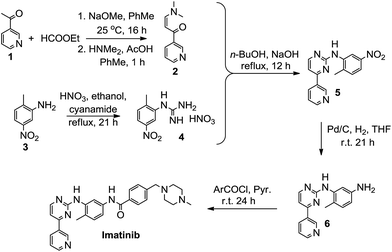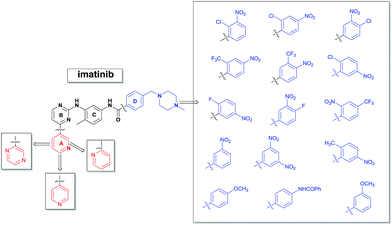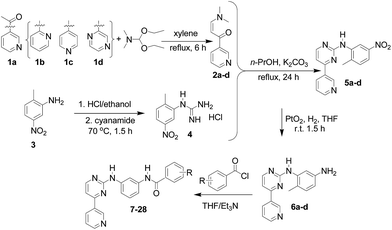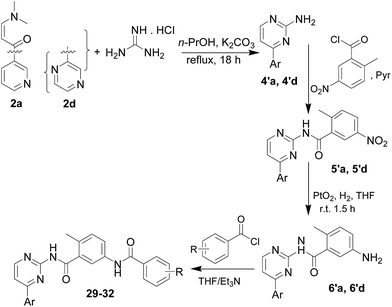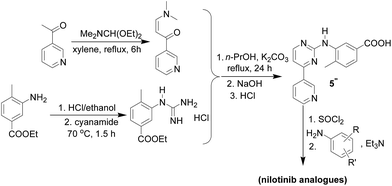An optimized approach in the synthesis of imatinib intermediates and analogues†‡
M. Kinigopouloua,
M. Filippidoua,
M. Gogoua,
A. Giannousia,
P. Foukaa,
N. Ntemoua,
D. Alivertisb,
C. Georgisa,
A. Brentasa,
V. Polychronidoua,
P. Voulgaria,
V. Theodorou*a and
K. Skobridis*a
aDepartment of Chemistry, University of Ioannina, GR-45110 Ioannina, Greece. E-mail: kskobrid@cc.uoi.gr; Fax: +30 265 1008682; Tel: +30 265 1008598
bDepartment of Biological Applications and Technology, University of Ioannina, GR-45110 Ioannina, Greece
First published on 15th June 2016
Abstract
We revisited the classical synthetic procedure for imatinib synthesis providing an improved and optimized approach in the preparation of a series of new imatinib analogues. The proposed methodology effectively overcomes certain problematic steps, saves time and labor, provides a very high yield and purity and has the potential to be used for the synthesis of many analogues. The formation of the desired guanidine salt 4, one of the key steps to the imatinib synthesis, was proceeded almost quantitatively by the reaction of the hydrochloride of the suitable aniline 3 with excess of molten cyanamide, without any solvent. Pure arylamine intermediates 6a–d were obtained quantitatively in a short reaction time after reduction of the nitro group of the intermediate pyrimidines 5a–d with hydrogen over the Adam's catalyst. In addition, the application of this optimized approach can be extended in the synthesis of nilotinib and its analogues intermediates.
1. Introduction
Tyrosine kinase inhibitors currently represent the most important class of anticancer drugs, based on the concept of targeted therapy. Imatinib (Glivec or Gleevec, Novartis) is the first clinically approved tyrosine kinase ATP-competitive inhibitor, established as a model for a revolutionized treatment of cancer. It is a specific inhibitor of Bcr-Abl kinase, which was used as a front-line therapy for the treatment of chronic myeloid leukemia (CML)1,2 and gastrointestinal stromal tumors (GISTs).3 However, secondary drug resistance is a main complication, caused by point mutations of Abl, after an initial positive response to imatinib.4 To overcome this problem, second generation of Bcr-Abl tyrosine kinase inhibitors are required. Extensive efforts have been devoted to the design and development of potent and more selective kinase inhibitors. Thus, a great number of structurally diverse compounds, such as nilotinib, a derivative of imatinib, sorafenib, dasatinib, have been developed.5–7Given the great potential of kinase inhibitors, they have attracted considerable interest in the reinvestigation of their synthesis and the optimum reaction conditions to construct them. Imatinib, the leading kinase inhibitor, provides an excellent model system to investigate how changes in chemical structure impact biological activity.
The original synthetic procedure to imatinib (Fig. 1), first reported by Zimmermann et al., was completed via several steps8 (Scheme 1). Four distinct building blocks, A, B, C and D (Fig. 2) were thought to bind together, building the imatinib structural motif. The lead structure pyridyl-2-phenylaminopyrimidine core (A + B + C) is bound through an amide bond with block D, while the N-methylpiperazinyl group was inserted by a nucleophilic substitution.
Zimmermann, in the imatinib synthesis by Novartis (Scheme 1), described the construction of the imatinib scaffold, through the key target compound phenylaminopyrimidine 5, derived by the condensation of the enaminone 2 of 3-acetylpyridine 1 and the guanidinium salt 4 obtained by the reaction of 2-methyl-5-nitroaniline 3 and cyanamide. After generating the functional aminopyrimidine core, a catalytic hydrogenolysis of the nitro group in the side chain to the corresponding primary arylamine 6 was conducted. Finally, after amide formation with the suitable benzoyl chloride, introduction of N-methylpiperazine substituent was achieved by SN2 displacement at the chloromethyl moiety of the acid chloride. This process, that combines great efficiency and facile isolation of intermediates, has been improved in certain steps in order to increase the overall efficiency for its industrial synthesis.
Recently, similar approaches have been utilized in a route to imatinib. Numerous synthetic methods, patented or not, have been successfully employed, regarding the modification of the above synthesis or the development of other sequences to overcome some problematic steps. In 2013, Ley et al. published an excellent and comprehensive review on the synthesis of imatinib, nilotinib and dasatinib.9a Loiseleur, Kompella, Wang, Szakacs, Ivanov, Carotti, Liu, Ley et al. provided varying synthetic processes, claiming improvements over the previous route.9b–j Despite considerable optimization, some of the approaches still suffer from low overall yield and, in some steps, long reaction time.
Our attempts were devoted to elaborate the synthesis of more active imatinib analogues,10 and to search for improvements in the existing synthetic methodology. In this paper, we report an efficiently optimized procedure for the synthesis of imatinib analogues in very high overall yields. In addition, we describe the synthesis of a series of other modified analogues, as potential potent kinase inhibitors.
2. Results and discussion
Our initial investigations focused on the construction of a series of new analogues, making variations on the A, C and D (Fig. 2) blocks and providing a modified synthetic protocol (Scheme 2). Keeping the original route to imatinib, Zimmermann's protocol, we reinvestigated all the steps, aiming to develop better reaction conditions for an optimized and efficient synthesis of the imatinib and its structurally related analogues.The most critical steps on the synthetic strategy, according to our protocol (Scheme 2), were the formation of the intermediate guanidinium salt 4 and the catalytic reduction of the nitro compound 5a–d to the primary arylamine 6a–d.
First, when implementing Zimmermann's protocol, only a very low yield (∼15%) of the key intermediate guanidinium salt 4 was obtained after a 20 h reaction (Scheme 1). In this protocol, several reaction conditions were screened, such as: the solvents MeOH, EtOH, n-PrOH, i-PrOH, n-BuOH, dioxane, THF, mixtures of them or organic solvent/H2O mixtures, diverse reaction temperatures, forcing conditions, several days of reflux, without considerable increase of the yield (15–25%). It is worth mentioning that Kompella et al., having adopted the commonly accepted Zimmermann's process described above, observed the same problem of very low yield (20–25%) for compound 4, confirming the process as non-economical.9c In an alternative route for the preparation of a guanidinium fragment9d by the use of cyanamide in the presence of HCl, the transformation yield was improved considerably (up to 85%).
To our surprise, in contrast to the above processes, when we performed this reaction without solvent, by the use of excess of molten cyanamide (mp 45 °C) and the hydrochloride salt of 2-methyl-5-nitro-aniline 3 at 65–70 °C, the desired guanidinium salt 4 was obtained almost quantitatively (∼98%). Complete conversion of 2-methyl-5-nitroaniline hydrochloride to the corresponding guanidinium hydrochloride 4 occured in just 1.5 h, instead of 20 h, gaining a considerable reduction of the reaction time and affording a very high yield. The cyanamide excess was easily removed and reused after precipitation by the addition of hexane.
Second, this was followed by condensation of enaminones 2a–d with the guanidinium salt 4 by heating in the presence of a base, a common and simple way to construct the pyrimidine core. The use of K2CO3 instead of NaOH, as the base, and in n-PrOH instead of n-BuOH or i-PrOH, as the solvent, of the Zimmermann's process, gave us pure products 5a–d (yield 81–86%), without the formation of byproducts and without the need of purification by column chromatography, optimizing further the cyclization reaction between the guanidinium intermediate 4 and the enaminones 2a–d.
During the catalytic reduction of compound 5a to the arylamine 6a by the described procedures, moderate yield and long reaction time were attained, while additional steps for the isolation of the product 6a were needed. Keeping the original route to imatinib, Kompella et al. described that the required product 6a was not formed.9c Kankan and Rao in their patented route9e described an improved process for the reduction of the nitro group, using SnCl2 in aqueous HCl (yield 65–70%, 2–4 h), while Szakacs et al. improved further the reaction,9f using SnCl2·2H2O in concentrated HCl (yield 81%, 30 min). Reduction with hydrazine and FeCl3 by the Liu process,9g gave the aniline in higher yield (83.4%).
Third, a rapid screening of alternative catalytic reduction of the nitro group of compounds 5a–d to the corresponding primary arylamines 6a–d was conducted. Employing hydrogen over the Adam's catalyst PtO2·H2O, we succeeded in gaining a notably improved yield in a short reaction time. Pure arylamines 6a–d were obtained quantitatively, avoiding unreacted starting material 5a–d or the corresponding nitroso- and hydroxylamino-intermediates, which were formed when we applied the Zimmermann's approach. The initially TLC detected intermediate reduction products were soon undetectable and only pure products were taken, which, without any other purification, were coupled with the suitable acid chloride to the desired final products 7–28.
Finally, the primary arylamines 6a–d were coupled with the suitably substituted benzoyl chloride, following the common method of amide bond formation used for the imatinib synthesis.
Using optimized reaction conditions, fortunately, we found that with our simple and time saving methodology, the structurally related new imatinib analogues were obtained in five-step synthesis in very high overall yields (58–63%) and in high analytical purity (>99.5%), and thus an increase in atom economy overall.
The above practical synthetic approach was employed for the synthesis of a wide range of compounds, as potential kinase inhibitors, exhibiting structural modifications in the A and D-ring systems (Fig. 2). In the present report, our modifications mainly concern (i) the pyridyl–pyrimidine key structure by varying the number and the position of nitrogens and (ii) the replacement of N-methylpiperazinyl group by, in general, withdrawing substituents in various places of the phenyl group (block D). The new analogues prepared by the present work, according to our optimized approach, have formulas as depicted in Table 1 (compounds 7–28).
| Compound | R1 | R2 | R3 | R4 | R5 |
|---|---|---|---|---|---|
| 7 | 3-Pyridyl | Cl | NO2 | H | H |
| 8 | 3-Pyridyl | Cl | H | NO2 | H |
| 9 | 3-Pyridyl | H | NO2 | Cl | H |
| 10 | 3-Pyridyl | CF3 | H | NO2 | H |
| 11 | 3-Pyridyl | H | CF3 | NO2 | H |
| 12 | 3-Pyridyl | F | H | H | NO2 |
| 13 | 3-Pyridyl | H | NO2 | F | H |
| 14 | 3-Pyridyl | Cl | H | H | NO2 |
| 15 | 3-Pyridyl | NO2 | H | CF3 | H |
| 16 | 3-Pyridyl | CH3 | H | H | NO2 |
| 17 | 2-Pyridyl | H | NHCOPh | H | H |
| 18 | 4-Pyridyl | H | NO2 | H | H |
| 19 | 4-Pyridyl | H | NO2 | H | NO2 |
| 20 | 4-Pyridyl | OCH3 | H | H | H |
| 21 | 4-Pyridyl | H | H | OCH3 | H |
| 22 | Pyrazinyl | Cl | NO2 | H | H |
| 23 | Pyrazinyl | Cl | H | NO2 | H |
| 24 | Pyrazinyl | H | NO2 | Cl | H |
| 25 | Pyrazinyl | CF3 | H | NO2 | H |
| 26 | Pyrazinyl | H | CF3 | NO2 | H |
| 27 | Pyrazinyl | F | H | H | NO2 |
| 28 | Pyrazinyl | H | NO2 | F | H |
| 29 | 3-Pyridyl | CF3 | H | NO2 | H |
| 30 | 3-Pyridyl | F | H | H | NO2 |
| 31 | Pyrazinyl | CF3 | H | NO2 | H |
| 32 | Pyrazinyl | F | H | H | NO2 |
Recently, we have also prepared a new series of analogues, replacing the NH group of the 2-aminopyrimidine ring with the alternative binding group NHCO, following the same protocol (Scheme 3) and providing a platform for further drug development, in order to improve their activities against protein kinases.
2-Aminopyrimidines, achieved by condensation of guanidine hydrochloride and dimethylamino-derivatives of the suitable enones, were benzoylated by benzoyl chlorides (ArCOCl) in order to obtain the N-benzoyl derivatives (Scheme 3). Despite the seeming simplicity of that transformation, some problems were raised during their synthesis. Surprisingly, treatment of 2-aminopyrimidines with substituted benzoyl chlorides, in the presence of Et3N, resulted in N,N-dibenzoyl derivatives and unreacted amine.11a We considered that the initial nucleophilic attack on the carbonyl of the acid chloride afforded the expected amide, which is more acidic than 2-aminopyrimidine. As soon as formed, it was deprotonated by the relatively strong base Et3N to form a further stabilized amide anion. The later reacted rapidly with a second molecule of the acid chloride to form the diacyl product. The expected N-monoacylated amide was attained in the presence of pyridine at rt, a very weak base that could not abstract the amide proton to form the anion.11a The intermediates nitro-derivatives 5′, after reduction with H2/PtO2·H2O, were coupled with the appropriate chlorides to the final products (Table 1, compounds 29–32). Workup procedure and purification for the reduction of the nitro group and the subsequent second amide bond formation were performed as described for compounds 7–28.
Following the previously described advantageous route, we extended our investigations into the scope of nilotinib analogues (Scheme 4).
Our first results showed again that good yields are obtained in the synthesis of the guanidinium salt (≈95%) and of the intermediate key compound phenylaminopyrimidine 5′′ (≈87%), analogous to the previous imatinib intermediate, bearing the ethyl ester group instead of the nitro group. After alkaline hydrolysis, the corresponding carboxylic acid 5′′ was coupled with the aniline fragment to yield a series of nilotinib analogues (Scheme 4).11b
3. Conclusions
In summary, a clean and efficient process for the synthesis of imatinib and analogues has been deployed, which represents a significant improvement over existing protocols, advantageous to the scientific community. This approach offers many benefits, including higher overall yields, simpler purification operations, considerable reduction time, while avoiding the need for additional steps. Furthermore, it has the potential to be successfully used for the synthesis of nilotinib, nilotinib analogues and any number of anticancer drugs.4. Experimental
4.1. General information
Solvents used were puriss, with the exception of THF, which was purified by fresh distillation over Na/benzophenone. Commercially available reagents were used without further purification. TLC analyses were conducted on commercial Merck silica gel 60 F254. Flash chromatography was carried out using silica gel 60 (230–400 mesh). Melting points (uncorrected) were determined with a Buchi 510 apparatus. 1H and 13C NMR spectra were recorded on a Brucker AMX (250/63 MHz 1H/13C, 300/75 MHz 1H/13C and 400/100 MHz 1H/13C) spectrometer using tetramethylsilane (TMS) as internal standard. Chemical shifts are reported in ppm (δ) referenced to TMS, coupling constants J in Hz. The high-resolution ESI mass spectra were obtained using a ThermoFisher Scientific Orbitrap XL and a Finnigan MAT-8200 spectrometer. Elemental analysis: Heraus CHN-Rapid Analyser; in %.4.2. General description of synthesis
Imatinib analogues, compounds 7–28, were prepared as shown in Scheme 2. Acetyl pyridines (2-, 3- and 4-) and acetyl pyrazine 1a–d were converted into the corresponding enaminones 2a–d by the use of N,N-dimethylformamide-diethylacetal. The enaminones were allowed to react with N-(2-methyl-5-nitrophenyl)-guanidinium hydrochloride 4, prepared from aniline hydrochloride 3 with excess of molten cyanamide, to the corresponding phenylamino-pyrimidines 5a–d. Catalytic hydrogenation of the nitro group of compounds 5a–d with PtO2 (Adam's catalyst) has finally leaded to the corresponding anilines 6a–d, which, subsequently, were coupled with the appropriate benzoyl chloride to afford the desired imatinib analogues 7–28.4.3. General procedure for the conversion of the acetylpyridines and acetylpyrazine to the enaminones 2a–d
A solution of N,N-dimethylformamide-diethylacetal (28.2 mL, 0.14 mol) in o-xylene (30 mL) was added dropwise under vigorous stirring to a solution of the suitable acetylpyridine (2- 3- or 4-) 1a–c (15 mL, 0.14 mol) or acetylpyrazine 1d (17.1 g, 0.14 mol) in o-xylene (30 mL) at rt. The reaction mixture was heated under reflux for 6 h, the solvent was then concentrated to a small volume and the residue was dispersed in diethyl ether (30 mL). The product was precipitated after cooling, isolated by filtration, washed with ice-cooled diethyl ether, and dried under vacuum.4.4. Preparation of N-(2-methyl-5-nitrophenyl)guanidinium hydrochloride (4)
Gaseous HCl was bubbled into an ice-cooled solution of 2-methyl-5-nitroaniline 3 (100 g, 0.65 mol) in MeOH (750 mL) until complete saturation (∼0.5 h). The mixture was stirred for 1 h at rt, then concentrated to dryness under reduced pressure, the residue was washed with diethyl ether (2 × 200 mL) and dried to give quantitatively 2-methyl-5-nitroaniline hydrochloride as a colourless solid. The hydrochloride salt (100 g, 0.55 mol) was added under stirring in a round-bottom flask with molten cyanamide (70 g, 1.67 mol) at 50 °C. The temperature was then raised at 65–70 °C and the mixture was stirred for 1.5 h, until complete conversion of 2-methyl-5-nitroaniline hydrochloride to the corresponding guanidinium hydrochloride 4, as established by TLC. The reaction mixture was then cooled to rt, diethyl ether (500 mL) was added to the oily residue and mixed vigorously with stirring for 30 min. The crude precipitate was filtered off, the solvent was removed and the residue was further treated with THF (300 mL) by vigorous stirring, in order to extract cyanamide traces. The product 4 was finally precipitated as white crystalline solid, filtered, washed with ice-cooled THF (100 mL) and dried under vacuum.Yield 97% (115.8 g). 1H NMR (250 MHz, D2O): δ 2.20 (s, 3H, CH3), 7.40 (d, J = 8.50 Hz, 1 arom. H), 7.81 (d, J = 2.00 Hz, 1 arom. H), 7.90 (dd, J = 8.50 Hz, 2.00, 1 arom. H). Ethereal mother liquors were further concentrated and hexane was added in order to precipitate and recover cyanamide excess.
4.5. General procedure for the preparation of the phenylamino-pyrimidines 5a–d
To a solution of N-(2-methyl-5-nitrophenyl)guanidinium hydrochloride 4 (4.61 g, 20 mmol) in 2-propanol (100 mL) was added the suitable enaminone 2a–d (20 mmol), excess of K2CO3 (6.22 g, 45 mmol) and the suspension was refluxed for 24 h. The reaction mixture was then cooled to rt, the precipitated product filtered, suspended in H2O and stirred vigorously. After stirring for 1 h, the product was filtered off, washed with a small amount of ice-cooled 2-propanol followed by diethyl ether and dried over P2O5 to yield a first crop of product. The filtrate was suspended in H2O (40 mL) and the precipitate was purified by column chromatography or by filtration after washing with ice-cooled 2-propanol and diethyl ether, yielding a second crop of the product. Specific details are given for each compound below.With 3-(dimethylamino)-1-(pyridin-3-yl)-prop-2-en-1-one: (yield 87%; mp 188–189 °C).
4.6. General procedure for the preparation of the phenylamino-benzamides 5′a, 5′d
A solution of the suitable freshly prepared 2-methyl-5-nitrobenzoyl chloride (1.2 mmol) in dichloromethane (5 mL) was added to a stirring mixture of pyridine (3 mmol) in dry dichloromethane (2 mL) at 0 °C under argon. The mixture was stirred for 5 min before the solution of the 2-aminopyrimidine (1 mmol) in dichloromethane (2 mL) was added over 10 min. The mixture was stirred for a further 3–6 h at rt, concentrated to dryness and the residue diluted with CH2Cl2, extracted with H2O, NaHCO3, H2O and finally with solution of KHSO4. The organic layer was washed with H2O, dried over Na2SO4, concentrated in vacuo and the residue was purified by silica gel column chromatography (CH2Cl2–MeOH, 9![[thin space (1/6-em)]](https://www.rsc.org/images/entities/char_2009.gif) :
:![[thin space (1/6-em)]](https://www.rsc.org/images/entities/char_2009.gif) 1) to afford the desired compounds.
1) to afford the desired compounds.
4.7. General procedure for reduction of the nitro compounds to the corresponding amines 6a–d
A mixture of the phenylamino-pyrimidine 5a–d (1.0 g, 3.36 mmol) and PtO2·H2O (0.2 g) in THF (30 mL) was vigorously stirred under a static H2 atmosphere at rt, and the progress of the reaction was monitored by TLC. The initially formed intermediate reduction products were soon not detectable and after about 1.5 h only the pure amino-compound was detected, without any starting material, or hydroxyamino- and nitroso-impurities. The catalyst was removed by filtration and the solvent evaporated under vacuum. The residue was treated with diethyl ether and hexane, concentrated again and dried under vacuum to give quantitatively the pure aniline derivatives, compounds 6a–d. The corresponding anilines 6a–d, were subsequently coupled without further purification with the appropriate benzoyl chlorides to the final compounds.4.8. General procedure for coupling of the amines to the corresponding amides 7–32 (Table 1, final compounds-imatinib analogues)
To an ice-cold solution of the suitable amine 6a–d (0.2 mmol) and triethylamine (0.25 mmol) in THF (20 mL) was added dropwise a solution of a substituted benzoyl chloride (0.25 mmol) in THF (10 mL). The mixture was stirred vigorously at 0 °C for 2 h, and at room temperature for 24 h, then was poured into ice and extracted with a saturated solution of K2CO3 and CH2Cl2. The precipitated product was filtered off, washed with water and dried over phosphorus pentoxide (P4O10) to yield a first crop of the product. A second crop of product was obtained from the organic phase, which was separated, washed with water and dried (Na2SO4). The solvent was evaporated under vacuum and the residue precipitated by the addition of diethyl ether and/or purified by flash chromatography on silica gel. The specific details for the imatinib analogues 7–13 were described in our previous publication,10a while specific details for each of the new imatinib analogues 14–32 are given below.Acknowledgements
This research project has been co-financed by the European Union (European Regional Development Fund—ERDF) and Greek national funds through the Operational Program–THESSALY-MAINLAND GREECE AND EPIRUS-2007-2013 of the National Strategic Reference Framework (NSRF 2007-2013). We thank the NMR Center and the Mass Spectrometry Unit of the University of Ioannina for taking the 1H/13C-NMR and HRMS spectra.References
- (a) J. Zimmermann, E. Buchdunger, H. Mett, T. Meyer, N. B. Lydon and P. Traxler, Bioorg. Med. Chem. Lett., 1996, 6, 1221 CrossRef CAS; (b) J. Zimmermann, E. Buchdunger, H. Mett, T. Meyer, N. B. Lydon and P. Traxler, Bioorg. Med. Chem. Lett., 1997, 7, 187 CrossRef CAS; (c) J. Zimmermann, G. Caravatti, H. Mett, T. Meyer, M. Müller, N. B. Lydon and D. Fabbro, Arch. Pharm., 1996, 7, 371 CrossRef; (d) R. Capdeville, E. Buchdunger, J. Zimmermann and A. Matter, Nat. Rev. Drug Discovery, 2002, 1, 493 CrossRef CAS PubMed; (e) B. J. Druker, C. L. Sawyers, H. Kantarjian, D. J. Resta, S. F. Reese, J. M. Ford, R. Capdewille and M. N. Talpaz, N. Engl. J. Med., 2001, 344, 1038 CrossRef CAS PubMed.
- (a) D. Fabbro, S. Ruetz, E. Buchdunger, S. W. Cowan-Jacob, G. Fendrich, J. Liebetanz, J. Mestan, T. O'Reilly, P. Traxler, B. Chaudhuri, H. Fretz, J. Zimmermann, T. Meyer, G. Caravatti, P. Furet and P. W. Manley, Pharmacol. Ther., 2002, 93, 79 CrossRef CAS PubMed; (b) J. M. Goldman and J. V. Melo, N. Engl. J. Med., 2001, 344, 1084 CrossRef CAS PubMed; (c) R. Capdeville, E. Buchdunger, J. Zimmermann and A. Matter, Nat. Rev. Drug Discovery, 2002, 1, 493 CrossRef CAS PubMed.
- (a) Y. Ma, S. Zeng, D. D. Metcalfe, C. Akin, S. Dimitrijevic, J. H. Butterfield, G. McMahon and B. J. Longley, Blood, 2002, 99, 1741 CrossRef CAS PubMed; (b) B. J. Longley, M. J. Reguera and Y. Ma, Leuk. Res., 2001, 25, 571 CrossRef CAS PubMed; (c) Y. Zermati, P. De Sepulveda, F. Féger, S. Létard, J. Kersual, N. Castéran, G. Gorochov, M. Dy, A. R. Dumas, K. Dorgham, C. Parizot, Y. Bieche, M. Vidaud, O. Lortholary, M. Arock, O. Hermine and P. Dubreuil, Oncogene, 2003, 22, 660 CrossRef CAS PubMed.
- (a) P. W. Manley, S. W. Cowan-Jacob and J. Mestan, Biochim. Biophys. Acta, 2005, 1754, 3 CrossRef CAS PubMed; (b) E. Weisberg, P. W. Manley, W. Breitstein, J. Brüggen, L. Callahan, S. W. Cowan-Jacob, D. Fabbro, G. Fendrich, E. Hall-Meyers, B. Huntley, A. Kung, J. Mestan, D. Neuberg, A. Ray, D. G. Gilliland and J. D. Griffin, Cancer Cell, 2005, 7, 129 CrossRef CAS PubMed; (c) C. B. Gambacorti-Passerini, R. H. Gunby, R. Piazza, A. Galietta, R. Rostagno and L. Scapozza, Lancet Oncol., 2003, 4, 75 CrossRef PubMed.
- (a) P. W. Manley, W. Breitenstein, J. Bróggen, S. W. Cowan-Jacob, P. Furet, J. Mestan and T. Meyer, Bioorg. Med. Chem. Lett., 2004, 14, 5793 CrossRef CAS PubMed; (b) E. Weisberg, P. Manley, J. Mestan, S. Cowan-Jacob, A. Ray and J. D. Griffin, Br. J. Cancer, 2006, 94, 1765 CrossRef CAS PubMed; (c) P. W. Manley, P. Drueckes, G. Fendrich, P. Furet, J. Liebetanz, G. Martiny-Baron, J. Mestan, J. Trappe, M. Wartmann and D. Fabbro, Biochim. Biophys. Acta, 2010, 1804, 445 CrossRef CAS PubMed; (d) D. L. Deremer, C. Ustun and K. Natarajan, Clin. Ther., 2008, 30, 1956 CrossRef CAS PubMed.
- (a) J. F. Lyons, S. Wilhelm, B. Hibner and G. Bollag, Endocr.–Relat. Cancer, 2001, 8, 219 CrossRef CAS PubMed; (b) S. Wilhelm and D. S. Chien, Curr. Pharm. Des., 2002, 8, 2255 CrossRef CAS PubMed; (c) S. M. Wilhelm, C. Carter, L. Tang, D. Wilkie, A. McNabola, H. Rong, C. Chen, X. Zhang, P. Vincent, M. McHugh, Y. Cao, J. Shujath, S. Gawlak, D. Eveleigh, B. Rowley, L. Liu, L. Adnane, M. Lynch, D. Auclair, I. Taylor, R. Gedrich, A. Voznesensky, B. Riedl, L. E. Post, G. Bollag and P. A. Trail, Cancer Res., 2004, 64, 7099 CrossRef CAS PubMed; (d) F. Carlomagno, S. Anaganti, T. Guida, G. Salvatore, G. Troncone, S. M. Wilhelm and M. Santoro, J. Natl. Cancer Inst., 2006, 98, 326 CrossRef CAS PubMed.
- (a) J. Das, P. Chen, D. Norris, R. Padmanabha, J. Lin, R. V. Moquin, Z. Shen, L. S. Cook, A. M. Doweyko, S. Pitt, S. Pang, D. R. Shen, Q. Fang, H. F. de Fex, K. W. McIntyre, D. W. Shuster, K. M. Gillooly, K. Behnia, G. L. Schieven, J. Wityak and J. C. Barrish, J. Med. Chem., 2006, 49, 6819 CrossRef CAS PubMed; (b) N. P. Shah, C. Tran, F. Y. Lee, P. Chen, D. Norris and C. L. Sawyers, Science, 2004, 305, 399 CrossRef CAS PubMed; (c) L. J. Lombardo, F. Y. Lee and P. Chen, et al., J. Med. Chem., 2004, 47, 6658 CrossRef CAS PubMed; (d) J. Tokarski, J. Newitt and F. Lee, et al., Blood, 2004, 104, 160 Search PubMed; (e) T. A. Carter, L. M. Wodicka and N. P. Shah, et al., Proc. Natl. Acad. Sci. U. S. A., 2005, 102, 11011 CrossRef CAS PubMed; (f) M. Wen, C. Shen, L. Wang, P. Zhang and J. Jin, RSC Adv., 2015, 5, 1522 RSC; (g) R. J. Ingham, E. Riva, N. Nikbin, I. R. Baxendale and S. V. Ley, Org. Lett., 2012, 14, 3920 CrossRef CAS PubMed.
- (a) J. Zimmermann, EP Patent 564, 409, 1993; (b) J. Zimmermann, US Pat., 5, 521, 184, 1996; (c) J. Zimmermann, US Pat., 5, 521, 184, 1996.
- (a) B. J. Deadman, M. D. Hopkin, I. R. Baxendale and S. V. Ley, Org. Biomol. Chem., 2013, 11, 1766 RSC; (b) O. Loiseleur, D. Kaufmann, S. Abel, H. M. Buerger, M. Meisenbach, B. Schmitz and G. Sedelmeier, W.O.Patent 03/066, 613, 2003; (c) A. Kompella, A. K. S. Bhujanga Rao and N. Venkaiah Chowdary, W.O. Patent 2004/108699, 2004; (d) A. Kompella, B. R. K. Adibhatla, P. R. Muddasani, S. Rachakonda, V. K. Gampa and P. K. Dubey, Org. Process Res. Dev., 2012, 16(11), 1794 CrossRef CAS; (e) R. N. Kankan and D. R. Rao, World Patent 2004/074502, 2004; (f) Z. Szakacs, S. Beni, Z. Varga, L. Orfi, G. Keri and B. Noszal, J. Med. Chem., 2005, 48, 249 CrossRef CAS PubMed; (g) Y. F. Liu, C. L. Wang, Y. J. Bai, N. Han, J. P. Jiao and X. L. Qi, Org. Process Res. Dev., 2008, 12, 490 CrossRef CAS; (h) A. S. Ivanov and S. Z. V. Shishkov, Monatsh. Chem., 2009, 140, 619 CrossRef CAS; (i) M. D. Hopkin, I. R. Baxendale and S. V. Ley, Chem. Commun., 2010, 46, 2450 RSC; (j) F. Leonetti, C. Capaldi and A. Carotti, Tetrahedron Lett., 2007, 48, 3455 CrossRef CAS.
- (a) K. Skobridis, M. Kinigopoulou, V. Theodorou, E. Giannousi, A. Russell, R. Chauhan, R. Sala, N. Brownlow, S. Kiriakidis, I. Domin, A. G. Tzakos and N. J. Dibb, ChemMedChem, 2010, 5, 130 CrossRef CAS PubMed; (b) K. Arvaniti, A. Papadioti, M. Kinigopoulou, V. Theodorou, K. Skobridis and G. Tsiotis, Proteomes, 2014, 2, 363 CrossRef CAS PubMed.
- (a) V. Theodorou, M. Gogou, A. Giannoussi and K. Skobridis, ARKIVOC, 2014,(iv), 11 Search PubMed; (b) K. Skobridis, V. Theodorou, et al., unpublished results.
Footnotes |
| † This article is dedicated to Professor Dieter Seebach, in recognition for his great contribution in organic chemistry. |
| ‡ Electronic supplementary information (ESI) available. See DOI: 10.1039/c6ra09812f |
| This journal is © The Royal Society of Chemistry 2016 |


